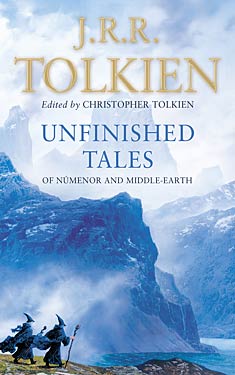J.R.R. Tolkien
Completed 4/12/2015, Reviewed 4/15/2015
4 stars
Most Tolkien fans probably
know that he had trouble finishing his work.
Even with the books he finished, he revised later editions. This was because he was constantly developing
his universe. Rather than simply writing
a new story in the universe and moving on, like many contemporary writers of
multi-story universes, he jumped around the timeline, making additions and
changes, evolving the characters and situations as his own understanding
evolved. “Unfinished Tales” presents
stories which he never quite finished, or had multiple or partial rewrites. In addition, his son Christopher adds lots of
commentary to help the reader understand the details and discrepancies in each
piece. The result is a mélange of amuses
bouche which while tasty, will leave the unprepared reader only partially
satisfied.
Like “The Silmarillion”, I
dove into this book with full ammunition: an open mind, “The Atlas of
Middle-Earth” by Karen Wynn Fonstadt, and 13 podcasts from Professor Corey
Olsen from tolkienprofessor.com’s Mythgard Academy. In general, I found the book generally
enjoyable, even the chapters where there were almost as many pages of notes as
there was text.
My favorite and perhaps the
easiest read is the story, or probably more accurately, the essay on the
Istari, the order of which Gandalf and Saruman were a part. It doesn’t answer all the questions, but even
Tolkien’s own lack of definitiveness is incredibly interesting. By contrast, “The History of Celeborn and
Galadriel” is not as satisfying as one would think. Within this text are three differing
collections of information about Galadriel’s life and role in
Middle-Earth. At times I had to stop and
look back to realize the story switched gears.
What helped me the most was Prof. Olsen’s analysis of the evolution of
Galadriel, from her conception for LOTR to the last treatment Tolkien gave her near
the end of his life.
I also find my appreciation growing
for the epic story of Turin Turambar. “Unfinished
Tales” gives a more detailed narrative of the beginning and end of his tale
than “The Silmarillion”. It’s an
incredibly tragic story, but marvelously conceived. It’s actually inspired by a story from the
Kalevala, the ancient epic Finnish poem, and integrated into the mythology of
Middle-Earth. After my first exposure to
it in “The Silmarillion” I was pretty bummed by it: murder, suicide, incest,
making Macbeth seem YA. Now after
reading this treatment of it, I’m greatly anticipating the full novel version that
Christopher put together a few years back.
About the only part of the
book I really didn’t like was the section on the formation of Rohan, mainly
because it mostly consists of detailed battle scenes. My regular readers know that that’s not my
favorite type of reading. No matter how
hard I try, my eyes glaze over and the next thing I know, I’m a few pages
further and completely lost. The reward
of this chapter, though, is that the success of these battles creates the
original alliance between Gondor and Rohan.
That part is beautifully written, and worth getting through the tough
part.
Ultimately, the nature of the
book is frustrating because the stories are, well, unfinished. No matter how much I prepared myself, when
the stories just stopped or histories revised multiple times within twenty
pages, I was left unfulfilled. Thank
goodness for the maps and the lectures.
They helped me regain my perspective.
And I think you have to maintain a strong balance between fan and
academician to read any kind of unfinished work. I give this book 4 out of 5 stars. Experiencing Tolkien at this level is great,
but is probably not for everyone. It’s
even less accessible than “The Silmarillion”.
The nature of the book does not lend itself to the emotional punch I
need to give it a full 5 star rating. I
think jumping back and forth between story and notes kept that dampered. But now that I’ve gotten this far, I’m just
hungrier for more, and am not put off by how difficult the twelve-volume “History
of Middle-Earth” probably is. So yeah, if
you haven’t guessed by now, I’m a fanboy.

No comments:
Post a Comment